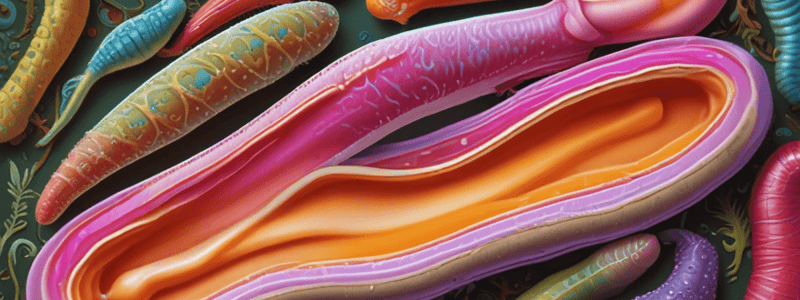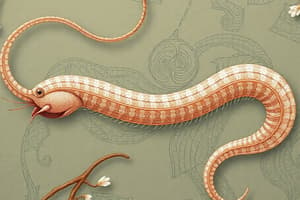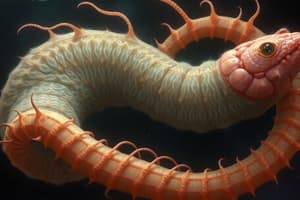Podcast
Questions and Answers
How many intermediate hosts does the Order Pseudophyllidea require?
How many intermediate hosts does the Order Pseudophyllidea require?
- 2 (correct)
- 3
- 1
- 0
What is the main method of attachment for Cestodes in the Order Cyclophyllidea?
What is the main method of attachment for Cestodes in the Order Cyclophyllidea?
- Rostellum
- Bothria and scolex
- Cilia
- Suckers and scolex (correct)
Where are all adult Cyclophyllidea found within their final host?
Where are all adult Cyclophyllidea found within their final host?
- Lungs
- Stomach
- Liver
- Small intestines (correct)
What is the purpose of the larvae in the life cycle of Cyclophyllidea?
What is the purpose of the larvae in the life cycle of Cyclophyllidea?
Which type of eggs have cilia for motility?
Which type of eggs have cilia for motility?
What is used by Pseudophyllidea for attachment to the host's organs?
What is used by Pseudophyllidea for attachment to the host's organs?
What happens if humans ingest infected human feces but there is no intermediate host present?
What happens if humans ingest infected human feces but there is no intermediate host present?
What feature is essential to note when trying to identify specific Cyclophyllidea species?
What feature is essential to note when trying to identify specific Cyclophyllidea species?
In which host are the proglottids found in the life cycle of Cyclophyllidea?
In which host are the proglottids found in the life cycle of Cyclophyllidea?
Why is it crucial to obtain a complete picture of a parasite for identification purposes?
Why is it crucial to obtain a complete picture of a parasite for identification purposes?
What is the number one preventable cause of epilepsy?
What is the number one preventable cause of epilepsy?
What is the primary method by which cestodes absorb nutrients?
What is the primary method by which cestodes absorb nutrients?
What type of life cycle do cestodes have?
What type of life cycle do cestodes have?
Which feature is NOT important when trying to identify a cestode species?
Which feature is NOT important when trying to identify a cestode species?
In cestodes, where are male and female reproductive organs typically located?
In cestodes, where are male and female reproductive organs typically located?
'Pearly beef' may lead to financial loss for farmers due to what reason?
'Pearly beef' may lead to financial loss for farmers due to what reason?
Which statement is true regarding larval stages in cestodes?
Which statement is true regarding larval stages in cestodes?
What clinical impact can heavy cestode infection have on young animals?
What clinical impact can heavy cestode infection have on young animals?
How many suckers can the cestode head (scolex) have?
How many suckers can the cestode head (scolex) have?
What is the term used to describe the segments in a cestode's body?
What is the term used to describe the segments in a cestode's body?
Which part of a cestode's body is most mature and developed?
Which part of a cestode's body is most mature and developed?
What do cestodes lack due to their lack of a body cavity?
What do cestodes lack due to their lack of a body cavity?
Which terminology is used refer to the body of the cestode?
Which terminology is used refer to the body of the cestode?
What is the major goal of Cyclophyllidea tapeworm parasites?
What is the major goal of Cyclophyllidea tapeworm parasites?
In which host does Taenia solium's adult stage reside?
In which host does Taenia solium's adult stage reside?
What is the term for the opening on the scolex of the cestode?
What is the term for the opening on the scolex of the cestode?
What is the primary reason dogs are dewormed for Cyclophyllidea tapeworms?
What is the primary reason dogs are dewormed for Cyclophyllidea tapeworms?
What is the term used to describe larva embedded in the muscle of cattle by Echinococcus species?
What is the term used to describe larva embedded in the muscle of cattle by Echinococcus species?
Which species serves as the intermediate host for Echinococcus tapeworms?
Which species serves as the intermediate host for Echinococcus tapeworms?
What is the clinical sign of Taeniasis in a human host?
What is the clinical sign of Taeniasis in a human host?
What is the role of oncospheres or hexacanth embryos in the life cycle of tapeworms?
What is the role of oncospheres or hexacanth embryos in the life cycle of tapeworms?
Where can larva of Taenia solium commonly be found within a pig?
Where can larva of Taenia solium commonly be found within a pig?
What is a possible consequence of larval infection with Taenia solium for humans?
What is a possible consequence of larval infection with Taenia solium for humans?
What is meant by 'pearly pork' in the context of the text?
What is meant by 'pearly pork' in the context of the text?
Where is Taenia solium commonly found according to the text?
Where is Taenia solium commonly found according to the text?
What is NCC referred to?
What is NCC referred to?
What can happen when humans ingest infected human feces containing the parasite Taenia solium?
What can happen when humans ingest infected human feces containing the parasite Taenia solium?
What is a key identifying factor when trying to identify cestode eggs?
What is a key identifying factor when trying to identify cestode eggs?
Flashcards are hidden until you start studying
Study Notes
Cestodes: General Info
- Cestodes are in the phylum Platyhelminthes and are also known as "tapeworms".
- They have a flat body and lack a body cavity (meaning that they lack intestines).
- Their flat body has segments of proglottids.
- They are hermaphroditic with both sex organs being present in each proglottid.
Cestodes: Body Structure
- The cestode body includes the proglottids (segments), strobila (body), head, and neck.
- The cestode head (AKA: scolex) has either 4 suckers or a bothria and can be armed or unarmed with hooks.
- Most have a rostellum (mouth opening).
- The cestode body (AKA: strobila) has proglottids (segments) and a mature posterior (portion of the body furthest from the scolex).
Order Pseudophyllidea
- Has 2 intermediate hosts, with the first IH being a crustacean.
- Uses BOTHRIA and scolex for attachment to the host's organs.
- Their eggs are contained in oncospheres but have cilia for motility.
Order Cyclophyllidea
- Has 1 intermediate host (IH).
- Uses 4 suckers and scolex for attachment to the host's organs.
- Their eggs are contained within an oncosphere.
- All adult cyclophyllidea are ALWAYS found within the small intestines of their final host, regardless of the animal being used as the host.
Order Cyclophyllidea: Life Cycle
- Step 1: The adult stage is found within the final host (dogs) where they use their rostellum to stay attached to the host's small intestines.
- Step 2: The proglottids are found within the feces (from the final host) where eggs are released from the proglottid.
- Step 3: The eggs are ingested by the IH (fleas) where the larvae will develop.
- Step 4: The final host can ONLY be infected by CONSUMING the infected IH.
Order Cyclophyllidea: Identification
- When trying to identify a cestode species, it is important to note:
- The size of the sucker
- Whether or not the sucker has hooks
- The shape of the sucker
- Whether or not a rostellum is present
- Whether or not the rostellum has hooks
- The shape, width, and length of the proglottid
- Whether or not fringe is present
- If there are 1 or 2 genital pores
- Where the glands are positioned
Clinical Relevance
- Some can be zoonotic
- Can cause clinical symptoms in young animals if the infection is heavy
- If "pearly beef" is present, the meat has to be condemned, which can cause a financial loss for farmers
- Larva invasion into the lungs or liver can cause illness in animals
- Cestodes do not rely on seasonality for infection because their host defecates all year long, which is their mode of infection, through the feces
Cestodes: Taenia solium
- Normal Life Cycle:
- Has a flattened shape and are hermaphroditic
- The adult stage is only found within the small intestines of the final host (humans)
- Clinical signs are rare within the final host
- The only clinical sign would be having an itchy anus (AKA: Taeniasis)
- Abnormal Life Cycle:
- If humans ingest infected human feces, they can become infected with this parasite
- The parasite develops into cysticercus in the brain
- This can be extremely deadly and very commonly leads to epilepsy
- Taenia solium is the number one most preventable cause of epilepsy
- Humans act as an aberrant and dead-end host in this abnormal life cycle where the human is infected with the larval stage of this parasite
- Larval infection in the human brain is referred to as NCC (neurocysticercosis)
Hydatic cysts: Echinococcus species
- When larva is found imbedded in the muscle of cattle, it is referred to as "pearly beef"
- This species of tapeworm has humans as their final host, and cows as their intermediate host
- The larva tend to imbed in the liver and lungs of the host
Studying That Suits You
Use AI to generate personalized quizzes and flashcards to suit your learning preferences.



